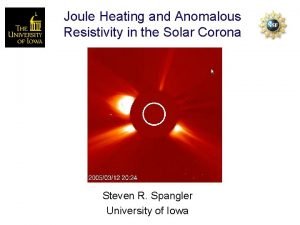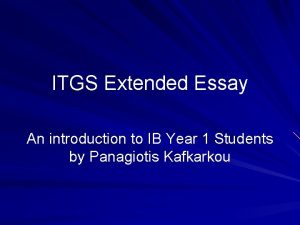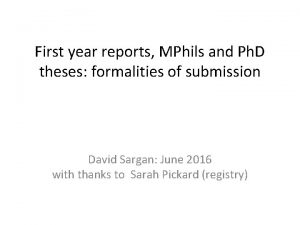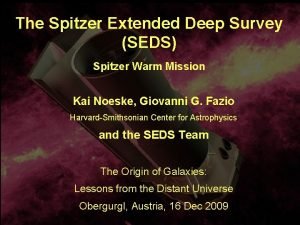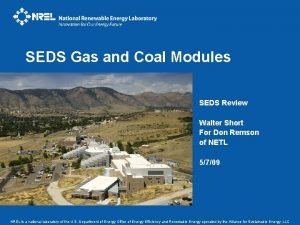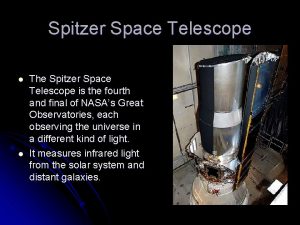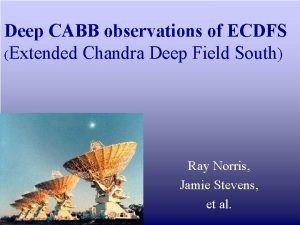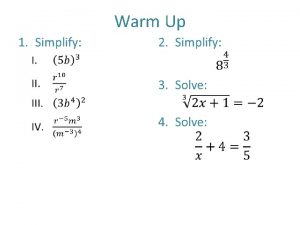Spitzer Warm Mission SEDS Spitzer Extended Deep Survey














- Slides: 14

Spitzer Warm Mission SEDS: Spitzer Extended Deep Survey Giovanni G. Fazio Harvard Smithsonian Center for Astrophysics and the SEDS Team

SEDS: Spitzer Extended Deep Survey • PI: Giovanni Fazio – 47 Co-I’s from 23 institutions • Primary Scientific Objective – Galaxy formation in the early Universe – Obtain first complete census of the assembly of stellar mass and black holes as a function of cosmic time back to the era of reionization – Series of secondary objectives • Unbiased survey 12 hrs/pointing at 3. 6 and 4. 5 microns ([3. 6] = 26 AB, 5 σ) in five well-studied fields (0. 9 sq deg) – 10 times area of deep GOODS survey • Total Time: 2108 hrs over 1. 5 years • No proprietary time on data

SEDS Co-Investigators Harvard Smithsonian Center for Astrophysics: Lars Hernquist, Matt Ashby, Jiasheng Huang, Kai Noeske, Steve Willner, Stijn Wuyts, T. J. Cox, Yuexing Li, Kamson Lai Max-Planck-Institut für Astronomie: Hans-Walter Rix, Eric Bell, Arjen van der Wel University of Califronia, Santa Cruz: Sandy Faber, David Koo, Raja Guhathakurta, Garth Illingworth, Rychard Bouwens NASA/GSFC: Sasha Kashlinsky, Rick Arendt, John Mather, Harvey Moseley Carnegie Observatories: Haojin Yan, Ivo Labbe, Masami Ouchi University of Pittsburgh: Jeff Newman Space Telescope Science Institute: Anton Koekemoer University of Arizona: Ben Weiner, Romeel Dave, Kristian Finlator, Eiichi Egami University of Western Ontario: Pauline Barmby Imperial College, London: Kirpal Nandra

SEDS Co-Investigators University of Chicago/KICP: Brandt Robertson Swinburne University: Darren Croton Stanford University/KIPAC: Risa Wechsler University of Florida, Gainesville: Vicki Sarajedini Astrophysikalisches Institute, Potsdam: Andrea Cattaneo University of Massachusetts, Amherst: Houjun Mo Royal Observatory Edinburgh: James Dunlop Institute of Astronomy and Astrophysics, Academia Sinica, Taiwan: Lihwai Lin National Research Council, Herzberg Institute of Astrophysics: Luc Simard Texas A&M University: Casey Papovich Tohoku University, Japan: Toru Yamada Oxford University: Dimitra Rigopoulou University of California, Riverside: Gillian Wilson

SEDS: Scientific Objectives • Galaxy Assembly in the Early Universe – Direct study of the mass assembly back to the era of reionization. • Study stellar masses and mass functions from z = 4 - 6 • Constrain high mass end of mass function at z = 7. – Measurement of spatial clustering of galaxies • Determine the evolution of galaxy properties as a function of halo masses. – Study of identified Lyα emitters at z = 5 - 7. • High z counterparts to dwarf galaxies? • Different sample compared to dropouts – Black hole evolution at z > 6. • Study of high-z AGN number counts (constrain evolutionary models) • Relationship to stellar growth – Tests of theoretical models of galaxy assembly • Numerical simulation models to tie observational effects together

SEDS: Scientific Objectives • Auxiliary Science – Galaxy Evolution from z ~ 1 - 4 • Nature of high-z galaxies • Mass assembly of galaxies • Emergence of quiescent galaxies – Mid-infrared Variability for AGN Identification • A more universal tracer of AGN – Measurement of the Cosmic Infrared Background radiation spatial fluctuations

SEDS: Technical Aspects • Sensitivity – 12 hrs/pointing at 3. 6 and 4. 5 microns – [3. 6] = 26 AB, 5 σ (0. 15 μJy) – Robustly measure M* (reach 5 x 109 Msun at z = 6) • Field Geometry and Configuration – Clustering and large scale structure at z = 6: > 20 - 30 arcmin – Correlation length: > 5 - 10 arcmin • Number of Fields – Cosmic variance: 5 fields • Field Selection – Fields with deep auxiliary data: Extended GOODS-S, Extended GOODS-N, UDS, EGS, COSMOS/Ultra. Vista

SEDS Survey Fields

Area Coverage vs Exposure Time

IMPACT OF COSMIC VARIANCE (Bright i′ -drops in four 1 deg 2 CFHTLS; Haojing Yan) D 1(2 h, -4 d)) D 2 (10 h, +2 d) (w/COSMOS) D 4(22 h, -18 d) D 3(14 h, +53 d) (overlap EGS)) 16. 5’x 10’ GOODSSize Area D 1: D 2: D 3: D 4 ~ 1. 2: 1. 7: 1. 0: 1, 8

SEDS: Technical Aspects • Expected Number of Sources – Statistically meaningful samples – Enough to derive mass functions and perform clustering studies – Finlator models: 8000, 2000, and 200 at z = 5, 6, and 7; few at z ~ 9. • Source Selection – Conventional Lyα “dropout” technique • Z = 4, 5, 6, and 7: B, V, i, and z

SED of a Lyα Galaxy at z = 6. 6 M. Ouchi et al. 2008

Expected Cumulative Number Density at z = 6 Ivo Labbe & Haojing Yan

Spitzer Extended Deep Survey (SEDS) • Opportunity to obtain unique information on galaxy formation and evolution in the early Universe • Extensive deep survey program that will leave an important legacy for years to come.
 Kurt spitzer
Kurt spitzer Spitzer resistivity
Spitzer resistivity Primary deviance definition
Primary deviance definition O the deep deep love of jesus
O the deep deep love of jesus Deep asleep deep asleep it lies
Deep asleep deep asleep it lies Deep forest towards an alternative to deep neural networks
Deep forest towards an alternative to deep neural networks Primary abcd
Primary abcd Extended response examples
Extended response examples Willamette leadership academy
Willamette leadership academy Extended producer responsibility
Extended producer responsibility Sub-coordinate bilingual
Sub-coordinate bilingual Itgs extended essay
Itgs extended essay Extended disc sverige
Extended disc sverige Extended response examples
Extended response examples Camsis self service
Camsis self service

